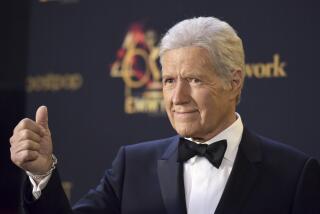Worldly Wise : Students Find a Geography Lesson in an Ordinary Pencil
- Share via
Remember geography class? Blank maps on smelly, damp mimeograph paper waiting to be filled in with countries, major rivers and mountain ranges? Arduous memorization of state capitals? Reports copied out of the Encyclopaedia Britannica?
It’s changed, at least at Bret Harte Elementary School in Burbank.
On Wednesday, quiz master Alex Trebek, host of the TV game show “Jeopardy!” and National Geographic Society President Gilbert Grosvenor led 35 fourth- and fifth-graders on an imaginary trip around the world, based on the countries that could supply raw material for a six-foot prop pencil. Students traced the itinerary on inflatable globes provided by National Geographic.
The classroom lesson was part of National Geography Awareness Week, declared following widespread criticism that U.S. students are woefully deficient in basic knowledge about the world. A federal study of students, for example, revealed in February that only 15% could identify the Soviet Union on a map and that 32% believed Finland has a hot climate.
Such results have prompted a rebirth of geography classes, with less emphasis on memorization and more on understanding how the global puzzle fits together.
The students in Larry Johnson’s class practically flew out of their seats to give answers. A sea of hands shot up: “Ooh. Me. I know.”
They didn’t always--some weren’t even close--but most of the time the kids were right on.
Not surprising. Johnson said he spends about 45 minutes each day dealing with some aspect of geography.
The pencil lesson began in the graphite mines of Sri Lanka.
It’s right under the southern tip of India, a student observed. It used to be called Ceylon, another said, surprising Trebek and Grosvenor.
“If you were on ‘Jeopardy!’ I would have given you some points,” Trebek told the girl.
From Sri Lanka, students followed an imaginary graphite-laden freighter of Liberian registry across the Indian Ocean, through the Suez Canal, across the Mediterranean and into the Atlantic to a Virginia pencil factory.
The students found every spot.
The cedar for the pencil shaft comes from the forests of the Pacific Northwest, mainly Oregon.
The zinc and copper components for the ferrule, the brass ring that holds the eraser, come from Peru and the Soviet Union, the world’s biggest country.
How big? Trebek asked.
“Really big,” one student answered. So big, in fact, that the country covers 11 time zones. Grosvenor explained that when it’s light in Siberia, it’s dark in Leningrad. And cold in both places.
Latex for the eraser comes from rubber trees, of which there are plenty in . . .
“My back yard,” a student volunteered.
Maybe, but these are in the jungles of Indonesia, northwest of Australia.
From Iceland, neighboring nothing but icy water, comes pumice, a volcanic rock that gives the eraser its abrasiveness.
The pencil still needed paint, and the lacquer comes from . . .
“The painted desert?”
Nope, Brazil.
Trebek reverted to game show host, offering a prize, a not-so-crisp dollar bill, for the answer to the question: What U.S. state is the farthest east?
“Maine?”
No.
“Virginia?”
No.
“Iceland?”
(Huh?)
“Alaska?”
No way, but wait . . . It is .
Brandon Day, 10, won a buck because the tip of the Aleutian Islands crosses the International Date Line into the Eastern Hemisphere.
A lucky guess, the cynical may scoff. But using his deflated globe as a visual aid, Brandon pointed out that “Alaska is closer to this side of the world and this is the east side.”
Useful things, deflated globes.
More to Read
Sign up for Essential California
The most important California stories and recommendations in your inbox every morning.
You may occasionally receive promotional content from the Los Angeles Times.













